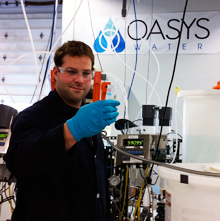A Cheaper Way to Clean Water
Oasys Water, a company that has been developing a novel, inexpensive desalination technology, showed off a new development facility in Boston this week. The company, which has been demonstrating commercial-scale components of its system in recent months, plans to begin testing a complete system early next year and to start selling the systems by the end of 2011.

Currently, desalination is done mainly in one of two ways: water is either heated until it evaporates (called a thermal process) or forced through a membrane that allows water molecules but not salt ions to pass (known as reverse osmosis). Oasys’s method uses a combination of ordinary (or forward) osmosis and heat to turn sea water into drinking water.
On one side of a membrane is sea water; on the other is a solution containing high concentrations of carbon dioxide and ammonia. Water naturally moves toward this more concentrated “draw” solution, and the membrane blocks salt and other impurities as it does so. The resulting mixture is then heated, causing the carbon dioxide and ammonia to evaporate. Fresh water is left behind, and the ammonia and carbon dioxide are captured and reused.
Oasys says the technology could make desalination economically attractive not only in arid regions where there are no alternatives to desalination, but also in places where fresh water must be transported long distances. In California, for example, a massive aqueduct system now transports water from north to south.
“The cost will be low enough to make aqueduct and dam projects look expensive in comparison,” says Oasys cofounder and chief technology officer Robert McGinnis, who invented the company’s core technology. The process could also require substantially less power than other desalination options. “The fuel consumption and carbon emissions will be lower than those of almost any other water source besides a local lake or aquifer,” he says.
The key to making the process work was developing a draw solution with easy-to-remove solutes, something that was done at a lab at Yale University. “Others have tried to develop other solutes for desalination,” McGinnis says, “but they haven’t been successful so far.”
The next-biggest technical challenge has been developing the membrane. The membranes used in reverse osmosis are unsuitable for this process because they work best at high pressures. Forward osmosis doesn’t use high pressures, so water moves through these membranes too slowly for the system to be practical. McGinnis and colleagues reëngineered the membranes, reducing the thickness of the supporting material and increasing its porosity without changing a very thin layer that blocks salts. These changes enabled water to pass through 25 times faster, McGinnis says.
The system uses far less energy than thermal desalination because the draw solution has to be heated only to 40 to 50 °C, McGinnis says, whereas thermal systems heat water to 70 to 100 °C. These low temperatures can be achieved using waste heat from power plants. Thermal-desalination plants are often located at power plants now, but it takes extra fuel to generate enough heat for them. The new system, on the other hand, could run on heat that otherwise would have been released into the atmosphere.
The Oasys system requires just one-tenth as much electricity as a reverse-osmosis system, McGinnis says, because water doesn’t have to be forced through a membrane at high pressure. That’s a crucial source of savings, since electricity can account for nearly half the cost of reverse-osmosis technology. Not working with pressurized water also decreases the cost of building the plant—there is no need for expensive pipes that can withstand high pressures. The combination of lower power consumption and cheaper equipment results in lower overall costs.
The Oasys system will not help everyone. For example, it is unlikely to do much for farmers; although they account for about 80 percent of fresh-water consumption, it wouldn’t be cost-effective for them, in part because farms are often located closer to aquifers and other water supplies than are large coastal cities such as L.A. In addition, “there’s a minimum amount of energy needed to strip salt ions out of water,” says Peter Gleick, president of the Pacific Institute for Studies in Development, Environment, and Security in Oakland, California. “I don’t think it will ever be cheap enough for irrigation.” In agricultural areas where water is scarce, he says, it’s cheaper to switch to better irrigation practices.
As coastal cities grow, however, so will their need for desalination services, says Kenneth Herd, director of the water supply program at the Southwest Florida Water Management District. “It’s not a matter of if,” he says, “but a matter of when.”
Keep Reading
Most Popular
Large language models can do jaw-dropping things. But nobody knows exactly why.
And that's a problem. Figuring it out is one of the biggest scientific puzzles of our time and a crucial step towards controlling more powerful future models.
How scientists traced a mysterious covid case back to six toilets
When wastewater surveillance turns into a hunt for a single infected individual, the ethics get tricky.
The problem with plug-in hybrids? Their drivers.
Plug-in hybrids are often sold as a transition to EVs, but new data from Europe shows we’re still underestimating the emissions they produce.
Stay connected
Get the latest updates from
MIT Technology Review
Discover special offers, top stories, upcoming events, and more.